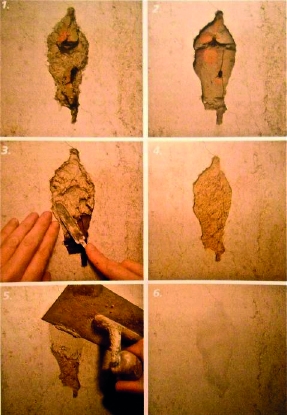REPAIRING INTERIOR FINISHES
REPAIRING INTERIOR FINISHES
CONSERVATION PHILOSOPHY
It is generally considered to be good practice that where the historic plaster is sound, it should be retained. Historic plasters are part of the fabric of the building and therefore should be retained in situ where practical and patched where required. Even if in plaster the plaster sounds hollow it may still be perfectly serviceable. If well haired, the original plaster will still retain its strength due to the matrix of fibres.
Providing the walls are dry, Ty Mawr Lime Hemp Plaster would be a good solution for patch repairs. It is especially useful for covering electrical ducting/ service cables.
 |
The sequence of a small patch repair. 1. The area to be patched. 2. The area should be cleaned back to the substrate. The edges should be slightly undercut using a sharp craft knife to help provide a key for the repair. 3. The are should be thoroughly dampened and the lime hemp plaster pressed onto the backing. The undercut edges should be supported whilst plasters is pressed into the recess - is using a standard haired base coat plaster (instead of using lime hemp), ensure it is well haired to reduce the risk of shrinkage. 4. The plaster should be brought up to 3mm below the finished level. It should be allowed to firm up, then should be keyed by scratching. 5. The base coat should be dampened down before fine lime hemp plaster (or for finer finish a standard lime finish plaster) is applied flush to the surface and dampened to control drying - as per the application guide. 6. The patched wall ready for painting. Please note: it may not be perfectly disguised but is part of the story and will add to the patina that makes old plasters beautiful. |
Lime finished should be finished with a vapour permeable paint - see our range of paints here.
Fine hairline cracks can be repaired with our Casein or General Purpose fillers.
